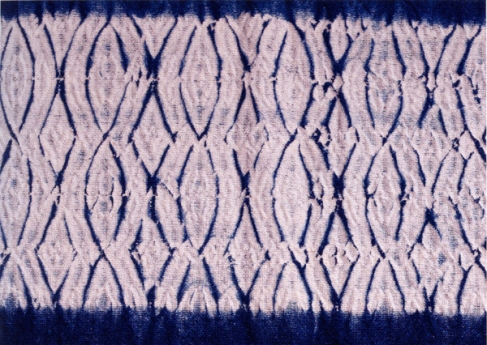Do Shibori or Don’t She?
Greetings, craft enthusiasts! I’m Beth and I’m a Fibers major here at the Craft Center. I’m slowly creeping my way toward my senior thesis work, and this semester I’ll occasionally be bringing you blog posts about what I’m doing.
Right now, what I’m doing is dressing a loom in preparation for woven shibori.
Hi! Don’t adjust your monitor; my hair really is blue.
Shibori is a traditional Japanese method of resist dyeing, which means that you use gathered stitches, wrapping and knotting, or even wooden blocks and clamps to keep dye from being applied to areas of the fabric. Yes, this even includes tie-dye, though that’s not one of the methods we learn and use here. A good resource to learn more is Yoshiko Iwamoto Wada’s Memory On Cloth, as well as her Shibori: The Inventive Art of Japanese Shaped Resist Dyeing.
Woven shibori takes this one step further and incorporates the actual weaving of the fabric into the process. Instead of sewing threads into the fabric afterward, the fabric is woven as it normally would be, with the addition of a supplementary weft which will be gathered after the weaving is completed. Between the pattern choices for threading the loom and treadling, there are thousands of designs for any curious weaver. Add in the different methods and colors you could use to dye your weaving, and the possibilities are countless.
Catherine Ellis is the developer of this method as well as the author of the book Woven Shibori, and it’s from her book that I’ve taken a couple of images to share with you.
 Woven Shibori, p. 5: 16-shaft twill variation
Woven Shibori, p. 5: 16-shaft twill variation
I love the way this undulates, and was hoping to reproduce it. Unfortunately, the Craft Center doesn’t have a loom capable of accommodating this specific pattern, so I’ll be adapting a different pattern to experiment with. You can see, though, that the dark parts are where the indigo dye has touched the fabric, and the light sections are where the supplementary weft has been gathered and therefore created a resist against the dye.
 Woven Shibori, p. 24: Purple Amber Petal Jacket by Candiss Cole. Photograph by John Cooper.
Woven Shibori, p. 24: Purple Amber Petal Jacket by Candiss Cole. Photograph by John Cooper.
Here we have a finished garment, not just a sample of flat fabric. This piece I find amazing in its ability to look like fire, even though it’s a woven piece of cloth. The flames appear to lick up the model’s back, and I find it utterly compelling.
I’m eager to explore the possibilities, and I shall bring you the results of my endeavors.


Leave a comment